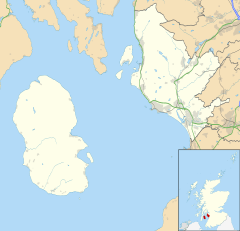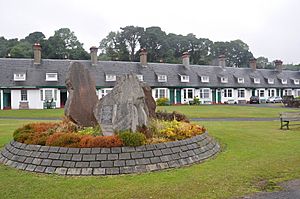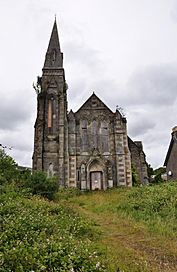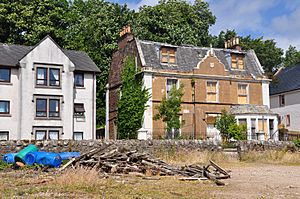Lamlash facts for kids
Quick facts for kids Lamlash
|
|
|---|---|
| Town | |
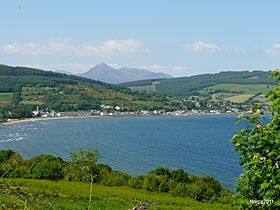 Lamlash sea front and part of Lamlash main town centre, May 2008 |
|
| Population | 1,100 (2020) |
| • Density | 7.01 (persons per hectare) |
| OS grid reference | NS028314 |
| • Edinburgh | 96 miles (154 km) |
| • London | 443 miles (713 km) |
| Civil parish |
|
| Council area | |
| Lieutenancy area |
|
| Country | Scotland |
| Sovereign state | United Kingdom |
| Post town | ISLE OF ARRAN |
| Postcode district | KA27 |
| Dialling code | 01770 |
| Police | Strathclyde |
| Fire | Strathclyde |
| Ambulance | Scottish |
| EU Parliament | Scotland |
| UK Parliament |
|
| Scottish Parliament |
|
Lamlash (which is An t-Eilean Àrd in Scottish Gaelic) is a lovely village on the Isle of Arran in Scotland. It sits in a calm bay on the island's east coast. From Lamlash, you can see the beautiful Holy Isle.
The village is about three miles south of Brodick, which is the main town and ferry port on Arran. Lamlash is important because it's where Arran's local government offices are. It also has the island's police station, secondary school, and hospital.
Like the rest of Arran, Lamlash mostly relies on tourism. Many people also work in public services, like the hospital or local government. Lamlash has an RNLI Lifeboat station. They use an Atlantic 75 lifeboat to help people in trouble near the coast of Arran. In summer, you can take a regular ferry from Lamlash harbour to Holy Isle. The village also has some old and interesting buildings, like Hamilton Terrace. These are rows of pretty cottages right on the seafront.
Contents
History of Lamlash
An old ring of stones shows that people have lived near Lamlash for a very long time. The name Lamlash comes from a Celtic monk named Saint Molaise. Around the year 590, he spent time in a cave on the nearby Holy Isle. People called him MoLaise. Because of him, Holy Isle was known in Gaelic as Eilean MoLaise. Over time, this name changed to Elmolaise, then Lemolash, and finally Lamlash. Until the early 1800s, Lamlash was actually the name for Holy Isle. After that, the name became linked to the village facing it.
Lamlash played a small part in the Battle of Largs in the 1200s. It was also the birthplace of the famous artist James Kay.
In 1548, during a war called the Rough Wooing, Mary, Queen of Scots was taken to France. Her ship had to turn back because of bad winds. It anchored safely at "Lamlash" on August 6.
During the early years of the Second World War, Lamlash was used as a training place for a special military group called No. 11 (Scottish) Commando.
Where is Lamlash?
Lamlash is in the southern part of the Isle of Arran. It is about three miles south of Brodick and five miles north of Whiting Bay. The village is on the eastern side of the island, right on a bay. It faces the Holy Isle and the wider Firth of Clyde.
Interesting Places to See
The village has many two and three-storey houses built along the shore road. The main church and the old St George's church are at each end of these buildings.
Hamilton Terrace Cottages
Hamilton Terrace is a special row of cottages. Numbers 1 to 27 are right on the Lamlash seafront. They are arranged in pairs. Behind these, there are more cottages (1a to 24a). These were probably built so that the main houses could be rented out to visitors in the summer. This was a common practice on Arran.
These cottages are a big part of the village's look. They were designed by Sir John James Burnet and built in the late 1800s. They still look much like they did when they were first built. One of the houses, number 27, is now the Lamlash Post Office. In front of the cottages, facing the sea, there used to be two garden areas. One of these is now a car park. On the grass between these areas, there is a modern monument. It remembers the people who had to leave Arran during the Clearances.
Clearances Monument
The Clearances were a time in the 1700s and 1800s when many people in Scotland were forced to leave their homes. This happened because of changes in farming. Many people moved to the coast, to other parts of Scotland, or even to North America.
The Clearances on Arran were not as harsh as in some other places. However, when farmers in Glen Sannox had to move to make way for large sheep farms, many decided to leave Scotland. They sailed from Lamlash. That is why Arran's Clearance Monument is in Lamlash, in front of Hamilton Terrace.
A plaque on the monument tells their story. It talks about how they left their island home for Canada between 1829 and 1840. On April 25, 1829, 86 people left on a ship called the Caledonia. A minister gave a sermon to them from a small hill nearby. The Caledonia arrived in Quebec City, Canada, on June 25, 1829. This group was the first of over 300 Arran families who settled in Quebec. Another large group of over 400 people went to Dalhousie, New Brunswick. The monument was put up by the Canadian descendants of these Arran families.
Churches in Lamlash
St George's United Free Church is at the northern end of Lamlash. It was built between 1885 and 1892 by the Duke of Hamilton. It replaced an older church from 1774. The church is made of cream-coloured sandstone and has a square stone tower with a weather vane.
This church was used until 1947 and has been empty since then. There have been plans to turn it into a theatre or a museum, but these plans have not happened. The building is considered "at risk" because it needs repairs.
The Lamlash and Kilbride Parish Church is another important church. It was built in 1886. It has a tower with nine bells. Inside, there is a cross and a baptismal font that were found in the old Kilbride Church graveyard in 1892. They are thought to be from the 1300s. The church hall next to it was built even earlier, around 1880, and was used for worship before the church itself was finished.
The Lookout Villa
The Lookout was an old villa from the early to mid-1800s. It was located on the main road near the shore. For a long time, it was marked as a 'Bank' on maps. In 2002, the local council stopped a plan to knock it down. They felt it was an important historic building that could be saved.
However, the building's condition got worse over time. Even though there were ideas to turn it into apartments, it was eventually torn down in March 2012.
Other Historic Buildings
- Glenkiln: A farmhouse from the mid-1800s, with two older cottages. It is one of only two farms left in Lamlash today.
- Monamore Bridge Millhouse: An old mill house from the early 1800s.
- Whitehouse Lodge: A lodge from the late 1800s that used to belong to a large mansion called the White House (which is now gone).
- Bellhaven: A cottage from 1808, located next to the Parish Church.
Other interesting buildings include the old pier house with its clock tower (from 1885), the 'Crafts Made in Arran' Shop, the stone pier itself, the Sea Gate, and the Bay Hotel. The Bay Hotel is a good example of an early Victorian villa.
Former Community Centre
The Lamlash Community Centre on Benlister Road was a large building. It was built by the Navy in 1914 to house sailors during World War I. It was put together quickly from ready-made parts. It had a canteen, reading rooms, offices, and a gym. Tents were set up nearby for soldiers. In 1917, it became a hospital for recovering soldiers.
After World War I, the building was given to the village. It was used again during World War II as a canteen for troops. The community centre was taken down in 2010. This happened after new community facilities opened at the new Arran High School nearby.
Lamlash Economy
Jobs in Lamlash
The main industry in Lamlash, like the rest of Arran, is tourism. Many people also work in public services, such as the hospital or local government. Fishing used to be very important in the Clyde area. However, there are not many fish left for commercial fishing now. The few fishermen remaining mostly catch scallops and prawns from the seabed.
Harbour and Lifeboat
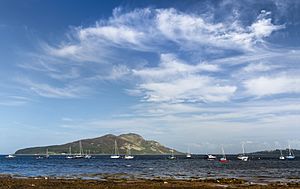
Lamlash Bay is a great natural harbour. It offers very good shelter for ships. In the past, it has even hosted large fleets of the Royal Navy.
Lamlash has an RNLI Lifeboat station. They have an Atlantic 75 lifeboat that helps people in the waters around Arran. In the summer, you can take a regular ferry from Lamlash harbour to Holy Isle.
Lamlash Bay Community Marine Protected Area
On September 20, 2008, a special rule called the "Inshore Fishing Order 2008" started. This rule stopped commercial and recreational fishing in the northern part of Lamlash Bay. This area is between Holy Island and the Margnaheglish area of Lamlash. This "No Take Zone" (NTZ) aims to protect special Maerl seaweed beds and help all marine life grow back.
It is hoped that this No Take Zone will help Lamlash's economy. It could attract scuba divers and lead to more and bigger catches for fishermen in nearby areas. This NTZ was the first of its kind in Scotland. It was also the first time a marine area was protected because of ideas from local people. This happened after a long effort by the Community of Arran Seabed Trust (C.O.A.S.T.). If someone breaks the fishing ban, they can face a large fine.
The sea around the south of Arran, including Lamlash, is now part of Scotland's 31 Mature Conservation Marine Protected Areas. This larger protected area includes the No Take Zone in Lamlash Bay, but it is not all a No Take Zone itself.
Images for kids
See also
 In Spanish: Lamlash para niños
In Spanish: Lamlash para niños


